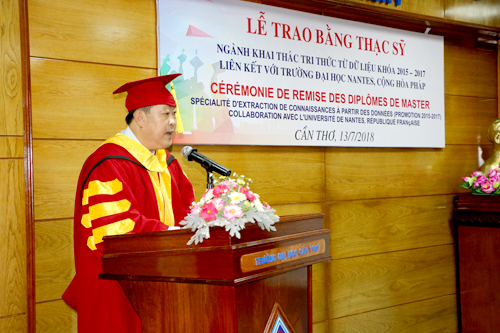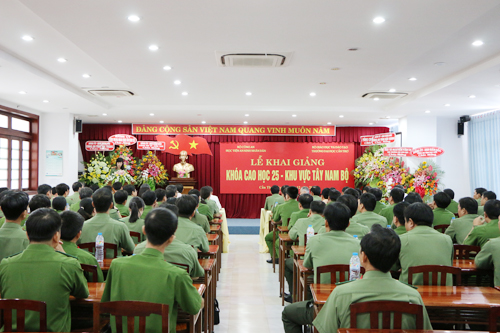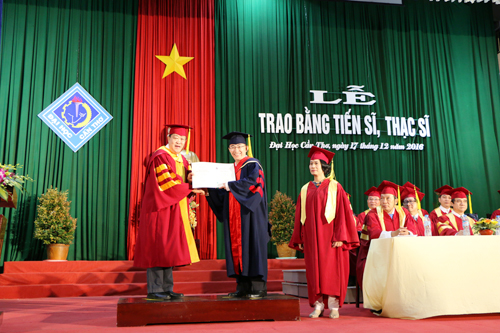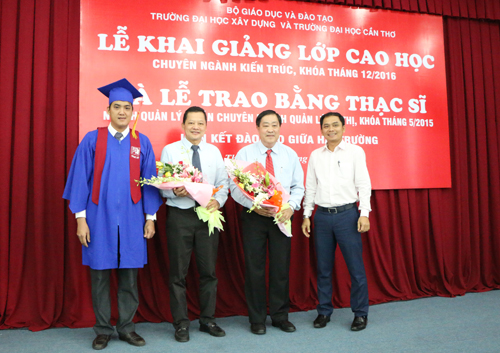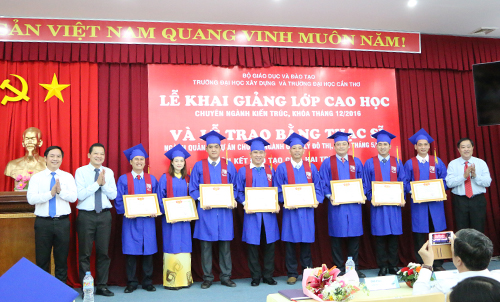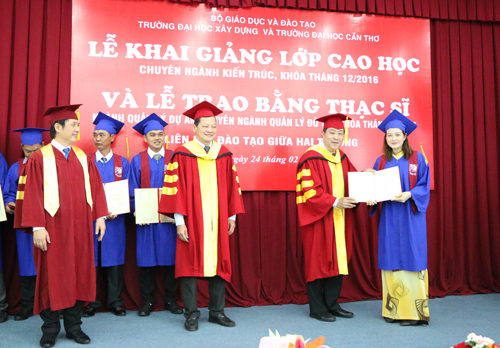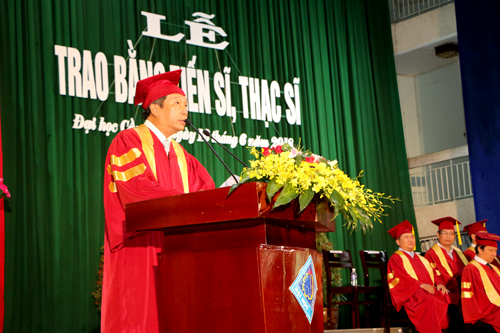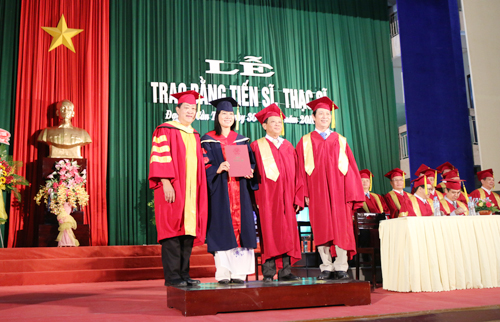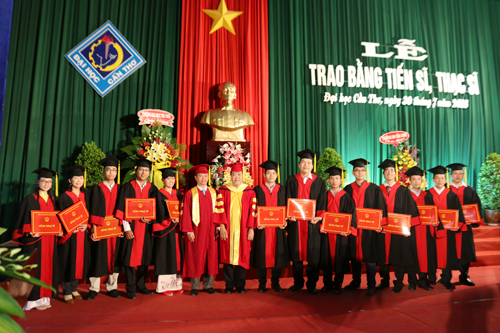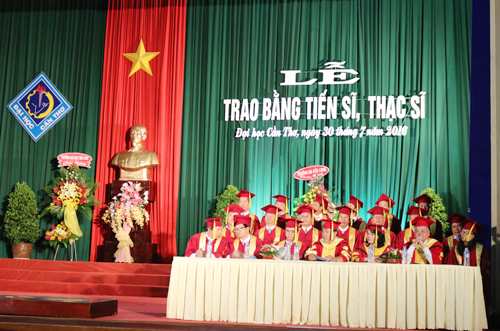Tên đề tài: “Đa dạng hóa sinh kế và thu nhập của hộ dân tộc Khmer ở Đồng bằng sông Cửu Long”
Tác giả: Ngô Thanh Vũ, Khóa: 2016
Chuyên ngành: Kinh tế nông nghiệp; Mã số: 62620115.
Người hướng dẫn: PGS.TS. Quan Minh Nhựt - Trường Đại học Cần Thơ
- Tóm tắt nội dung luận án
Luận án là phân tích các yếu tố tác động đa dạng hóa sinh kế và sự ảnh hưởng của đa dạng hóa sinh kế đến thu nhập để đề xuất các giải pháp nhằm cải thiện đời sống của hộ dân tộc Khmer ở ĐBSCL. Luận án sử dụng bộ dữ liệu bảng (panel data) được khảo sát lặp lại trong hai năm (2018 và 2020) từ 285 hộ người dân tộc Khmer tại ba tỉnh Sóc Trăng, Trà Vinh và An Giang thuộc Đồng bằng sông Cửu Long, thông qua bảng hỏi cấu trúc được soạn sẵn. Sử dụng phương pháp phân tích chéo để tìm ra mối quan hệ giữa các nguồn vốn cũng như thu nhập đối với đa dạng hóa sinh kế của hộ Khmer. Ngoài ra, luận án sử dụng phương pháp hồi quy biến công cụ và hồi quy bình phương nhỏ nhất hai giai đoạn (2SLS) để xử lý vấn đề nội sinh trong mô hình từ đó xác định các yếu tố ảnh hưởng đến đa dạng hóa sinh kế và tác động của đa dạng hóa sinh kế đến thu nhập của nông hộ. Các yếu tố được xác định để ước lượng trong mô hình: Tuổi chủ hộ, trình độ học vấn chủ hộ, quy mô hộ gia đình, đào tạo nghề, nhà ở, phương tiện sản xuất, vay, tiết kiệm, diện tích đất sản xuất, tham gia các hiệp hội, mối quan hệ xã hội, chi phí quan hệ xã hội, hỗ trợ từ chính phủ, hỗ trợ từ người thân, trường nghề, những rủi ro từ thiên nhiên, lượng mưa.
Từ khóa: Đa dạng hóa sinh kế, hồi quy biến công cụ, hồi quy bình phương nhỏ nhất 2 giai đoạn, dân tộc Khmer, Đồng bằng sông Cửu Long.
- Những kết quả mới của luận án
Một là, kết quả nghiên cứu cho thấy số lượng nghề bình quân của hộ Khmer trung bình là 2,166 nghề/hộ trong giai đoạn 2018-2020, nghiên cứu cũng chỉ ra rằng có 14 yếu tố tác động đến đa dạng hóa sinh kế của hộ Khmer vùng ĐBSCL, đó là: trình độ học vấn, quy mô gia đình, phương tiện sản xuất, tham gia hiệp hội, mối quan hệ xã hội, tuổi chủ hộ, đào tạo nghề, tiết kiệm, hỗ trợ của chính phủ, trường dạy nghề và lượng mưa. Bên cạnh đó, nghiên cứu cũng nhận thấy rằng có mối quan hệ giữa đa dạng hóa sinh kế và thu nhập của hộ Khmer, các hộ có mức độ đa dạng hóa sinh kế càng cao thì thu nhập càng tăng trong giai đoạn 2018 - 2020.
Hai là, nghiên cứu khi phân tích tác động của đa dạng hóa sinh kế đến thu nhập của hộ Khmer trong giai đoạn 2018 - 2020 bằng cách sử dụng cả 3 mô hình 2SLS, GMM và GMM - REM đều cho thấy có 06 yếu tố tác động đến thu nhập của hộ Khmer vùng ĐBSCL, đó là: SID, năm phỏng vấn, trình độ học vấn, diện tích đất sản xuất và mối quan hệ xã hội. Kết quả nghiên cứu trong mô hình GMM - REM cũng cho thấy năm 2020 các hộ Khmer đã có sự thay đổi thu nhập đáng kể hơn so với năm 2018.
Ba là, trên cơ sở kết quả nghiên cứu, luận án đã đề xuất bốn nhóm giải pháp làm tăng mức độ đa dạng hóa sinh kế của hộ Khmer vùng ĐBSCL gồm: (1) Nhóm giải pháp về cải thiện và nâng cao các nguồn vốn sinh kế hộ Khmer; (2) Nhóm giải pháp về cải thiện khả năng đa dạng hoá sinh kế đảm bảo đời sống ổn định thu nhập của hộ dân tộc Khmer ở ĐBSCL; (3) Nhóm giải pháp về phát triển sinh kế bền vững của hộ Khmer vùng ĐBSCL và (4) Nhóm giải pháp về ứng dụng tiến bộ khoa học kỹ thuật nhằm đẩy mạnh đa dạng hóa sinh kế phù hợp với văn hóa của người Khmer vùng ĐBSCL.
- Các ứng dụng/khả năng ứng dụng trong thực tiễn, các vấn đề cần tiếp tục nghiên cứu
Về mặt khoa học:
Thứ nhất: Nghiên cứu hệ thống hóa đầy đủ các lý thuyết, phương pháp phân tích tác động đa dạng hóa sinh kế đến thu nhập của hộ Khmer tại Đồng bằng sông Cửu Long.
Thứ hai: Nghiên cứu bổ sung đánh giá thêm những nguồn lực ảnh hưởng đến đa dạng hóa sinh kế và thu nhập mà những nghiên cứu trong nước trước đây chưa đề cập đến.
Thứ ba: Nghiên cứu là một công trình thử nghiệm kết hợp giữa nghiên cứu hàn lâm lặp lại và nghiên cứu ứng dụng, qua đó xây dựng và kiểm định mô hình nghiên cứu dựa trên cả 3 mô hình hồi quy là 2SLS, GMM và GMM-REM. Chính vì vậy, kết quả nghiên cứu phản ánh độ tin cậy cũng như bổ sung và phát triển về mặt phương pháp luận trong đánh giá các yếu tố ảnh hưởng đến đa dạng hóa sinh kế và thu nhập. Từ đó, nghiên cứu đề xuất các giải pháp khả thi.
Về mặt thực tiễn:
Thứ nhất: Nghiên cứu đa dạng hóa sinh kế đã được thực hiện khá phổ biến ở nước ta. Tuy nhiên, các nghiên cứu chỉ dừng lại ở việc xác định được đối tượng ảnh hưởng đến đa dạng hóa sinh kế để ổn định thu nhập, đảm bảo đời sống cho hộ gia đình mà rất ít nghiên cứu xác định được mối quan hệ giữa đa dạng hóa sinh kế sẽ tác động như thế nào đến nguồn thu nhập của nông hộ, do vậy rất khó đề ra những chính sách cụ thể cũng như định hướng phù hợp cho nông hộ khi đa dạng hóa. Bên cạnh đó, đối với vùng ĐBSCL việc tiếp cận sinh kế được các nhà nghiên cứu, các tổ chức đề cập đến với mục tiêu và đối tượng nghiên cứu chủ yếu là sinh kế của nông hộ trong vùng, chưa có nghiên cứu bài bản nào về đa dạng hóa sinh kế đối với hộ Khmer vùng ĐBSCL. Trong khi đó, hộ dân tộc Khmer được xác định là một trong 32 dân tộc còn gặp nhiều khó khăn sinh sống ổn định thành cộng đồng trên địa bàn các xã khu vực III và các thôn đặc biệt khó khăn thuộc vùng đồng bào dân tộc thiểu số và miền núi giai đoạn 2021 - 2025, được phê duyệt tại quyết định số 1227/QĐ-TTg ngày 14 tháng 7 năm 2021 của Thủ tướng Chính phủ. Vì vậy, nghiên cứu các yếu tố tác động đa dạng hóa sinh kế và sự ảnh hưởng của đa dạng hóa sinh kế đến thu nhập từ đó đề xuất các hàm ý chính sách nhằm cải thiện đời sống của hộ dân tộc Khmer ở ĐBSCL là rất cần thiết.
Thứ hai: Luận án sử dụng dữ liệu bảng (panel data) nghiên cứu quan sát trong giai đoạn 2018 - 2020 để đưa ra chính xác hơn kết quả đo lường các yếu tố tác động đến đa dạng hóa sinh kế, cũng như sự ảnh hưởng của đa dạng hóa sinh kế đến thu nhập. Từ đó, luận án có thể đưa ra các hàm ý chính sách phù hợp với tình hình đời sống của hộ Khmer vùng ĐBSCL hiện nay.
Thứ ba: Nghiên cứu đã xây dựng bốn nhóm giải pháp đề xuất nhằm thực hiện mục tiêu đa dạng hóa sinh kế, đảm bảo thu nhập, ổn định cuộc sống, góp phần xóa đói giảm nghèo cho người dân tộc Khmer vùng ĐBSCL, bao gồm: (1) Nhóm giải pháp về cải thiện và nâng cao các nguồn vốn sinh kế hộ Khmer; (2) Nhóm giải pháp về cải thiện khả năng đa dạng hoá sinh kế đảm bảo đời sống ổn định thu nhập của hộ dân tộc Khmer ở ĐBSCL; (3) Nhóm giải pháp về phát triển sinh kế bền vững của hộ Khmer vùng ĐBSCL và (4) Nhóm giải pháp về ứng dụng tiến bộ khoa học kỹ thuật nhằm đẩy mạnh đa dạng hóa sinh kế phù hợp với văn hóa của người Khmer vùng ĐBSCL.
Từ những đóng góp đó, có thể xem luận án là một tài liệu tham khảo mang tính thực tiễn, giúp các cơ quan quản lý hiểu rõ đặc điểm hộ Khmer và các nguồn lực đem đến thu nhập của hộ Khmer để vận dụng xây dựng chính sách trong việc quản lý phát triển đối với đồng bào dân tộc Khmer nói riêng và đối với đồng bào dân tộc thiểu số nói chung.
Thesis title: “diversification of livelihoods and income for khmer ethnic households in the mekong delta”.
- Specialization: Agricultural Economics Mã số: 62620115
- Full name of PhD student: Ngo Thanh Vu Training period: 2016 - 2020
- Supervisor: Assoc. Prof. PhD Quan Minh Nhut - Can Tho University
- Training institution: Can Tho University
- Dissertation summary
The dissertation focuses on analyzing the various determinants of agricultural livelihood diversification and the implications of such diversification on income levels. The objective is to propose strategies for enhancing the well-being of Khmer ethnic households in the Mekong Delta. The study utilizes a panel dataset collected over a two-year period (2018 and 2020) from 285 Khmer households residing in the provinces of Soc Trang, Tra Vinh, and An Giang, situated within the Mekong Delta. The data collection process involves employing predefined structured questionnaires. To identify the relationship between sources of capital, income, and agricultural livelihood diversification among Khmer households, cross-sectional analysis techniques are applied. Furthermore, the research employs instrumental variable regression and two-stage least squares regression (2SLS) methodologies to address endogeneity concerns inherent in the model. These techniques aid in determining the factors influencing agricultural livelihood diversification and the subsequent impacts on the income of farming households. The model incorporates a range of factors for estimation purposes, encompassing variables such as the age of the household head, the educational attainment of the household head, family size, vocational training participation, housing conditions, production resources, borrowing and saving behaviors, agricultural land allocation, engagement in local associations, social networks, costs associated with social relationships, government assistance, familial support, vocational education availability, exposure to natural risks, and precipitation levels.
Keywords: Livelihood diversification, instrumental variable regression, two-stage least squares regression, Khmer ethnic group, Mekong Delta.
- New results of the thesis
Firstly, the research findings indicate that the average number of livelihoods per Khmer household is 2.166 during the period 2018-2020. The study further identifies 14 factors that influence livelihood diversification among Khmer households in the Mekong Delta. These factors encompass educational level, family size, production resources, participation in associations, social relationships, household head's age, vocational training, savings practices, government support, vocational education availability, and rainfall. Moreover, the study establishes a correlation between livelihood diversification and the income of Khmer households. It reveals that households with higher levels of livelihood diversification experience an increase in income during the period 2018-2020.
Secondly, the study examines the impact of livelihood diversification on the income of Khmer households during the period 2018-2020 using three models: 2SLS, GMM, and GMM-REM. All three models reveal that six factors influence the income of Khmer households in the Mekong Delta. These factors include SID (presumably an identifier), interview year, educational level, agricultural land area, and social relationships. The findings from the GMM-REM model also indicate that in the year 2020, Khmer households experienced a significant change in income compared to the year 2018.
Thirdly, based on the research results, the thesis has proposed four groups of solutions to increase the level of livelihood diversification among Khmer households in the Mekong Delta. These include: Solution Group for Enhancing and Augmenting Livelihood Capital: This group focuses on improving and elevating the sources of livelihood capital for Khmer households. It involves strategies to enhance financial resources, education, training, and productive assets. Solution Group for Enhancing the Capacity of Sustainable Livelihood Diversification: This group aims to enhance the capability to diversify livelihoods in order to ensure stable income for Khmer ethnic households in the Mekong Delta. It encompasses tactics to broaden the range of income-generating activities and develop skills that ensure income stability. Solution Group for Sustainable Livelihood Development: This group addresses the establishment of sustainable livelihoods for Khmer households in the Mekong Delta. It encompasses strategies promoting environmentally friendly and resilient livelihood activities, ensuring long-term well-being. Solution Group for Applying Scientific and Technological Advancements: This group proposes the application of scientific and technological progress to strengthen livelihood diversification in alignment with the cultural context of the Khmer people in the Mekong Delta.
- Practical applications/applicability, issues that need further research
In terms of the science aspect
Firstly, the study comprehensively systematizes various theories and analytical methods that investigate the impact of livelihood diversification on the income of Khmer households in the Mekong Delta.
Secondly, the research supplements and extends the assessment of additional resources that influence livelihood diversification and income, which previous domestic studies have not addressed.
Thirdly, the research is an experimental endeavor combining academic and applied dimensions. It involves constructing and validating a research model by integrating three regression models: 2SLS, GMM, and GMM-REM. Consequently, the research outcomes reflect a high degree of confidence and contribute to enhancing and developing methodological approaches in evaluating factors influencing livelihood diversification and income. As a result, the study proposes feasible solutions based on the findings.
Issues for further research:
Firstly, livelihood diversification studies have been quite prevalent in our country. However, these studies have mostly focused on identifying the factors that influence livelihood diversification to stabilize income and ensure household well-being. Few studies have delved into establishing how the relationship between livelihood diversification and income affects farming households, making it challenging to formulate specific policies or appropriate directions for diversification. Additionally, concerning the Mekong Delta, researchers and organizations have primarily targeted livelihoods of farming households, without conducting comprehensive research on livelihood diversification among Khmer households in the area. Notably, the Khmer ethnic households have been identified as one of the 32 ethnic groups facing challenges in achieving stable livelihoods as communities in areas designated as Zone III and particularly difficult hamlets within ethnic minority and mountainous during the period of 2021-2025, as stipulated in Prime Minister's Decision No. 1227/QD-TTg dated July 14, 2021. Therefore, it is essential to study the factors impacting livelihood diversification and the effects of such diversification on income. This would allow for proposing policy implications aimed at improving the living conditions of Khmer ethnic households in the Mekong Delta.
Secondly, the dissertation employs panel data collected during the period 2018-2020 to provide more accurate measurements of the factors influencing livelihood diversification and the impact of such diversification on income. This approach enables the thesis to offer policy implications that align with the current living conditions of Khmer households in the Mekong Delta.
Thirdly, the research has formulated four solution groups to achieve the objective of livelihood diversification, ensuring income stability, improving living conditions, and contributing to poverty alleviation for the Khmer ethnic community in the Mekong Delta. These solution groups include: Solution Group for Enhancing and Augmenting Livelihood Capital: This group focuses on improving and elevating the sources of livelihood capital for Khmer households. Solution Group for Enhancing the Capacity of Sustainable Livelihood Diversification: This group aims to enhance the capability to diversify livelihoods to ensure stable income for Khmer ethnic households in the Mekong Delta. Solution Group for Sustainable Livelihood Development: This group addresses the establishment of sustainable livelihoods for Khmer households in the Mekong Delta, focusing on environmentally friendly and resilient livelihood activities. Solution Group for Applying Scientific and Technological Advancements: This group proposes the application of scientific and technological progress to strengthen livelihood diversification that is culturally appropriate for the Khmer people in the Mekong Delta. These proposed solution groups aim to support the livelihoods of Khmer households, contributing to their overall well-being and helping to alleviate poverty in the Mekong Delta..
From these contributions, the dissertation can be seen as a practical reference document that aids government agencies in understanding the characteristics of Khmer households and the resources contributing to their income. This understanding can be utilized to formulate policies for managing development specifically for the Khmer ethnic community and more broadly for ethnic minority communities.
- Xem chi tiết nội dung luận án
- Xem thông tin đăng tải tại Website Bộ giáo dục và Đào tạo. (Nhập tên NCS vào ô tìm kiếm)





